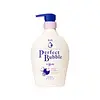What's inside
What's inside
 Key Ingredients
Key Ingredients

No key ingredients
 Benefits
Benefits

 Concerns
Concerns

 Ingredients Side-by-side
Ingredients Side-by-side

Water
Skin ConditioningSodium Laureth Sulfate
CleansingCocamidopropyl Betaine
CleansingSodium Chloride
MaskingDecyl Glucoside
CleansingGlycerin
HumectantDisodium Cocoamphodiacetate
CleansingHoney Extract
HumectantPEG-60 Hydrogenated Castor Oil
EmulsifyingPolysorbate 20
EmulsifyingPEG-150 Distearate
EmulsifyingPolyquaternium-7
Citric Acid
BufferingDisodium EDTA
Butter Extract
EmollientBeta-Glucan
Skin ConditioningMagnesium Nitrate
Magnesium Chloride
Methylchloroisothiazolinone
PreservativeMethylisothiazolinone
PreservativeWater, Sodium Laureth Sulfate, Cocamidopropyl Betaine, Sodium Chloride, Decyl Glucoside, Glycerin, Disodium Cocoamphodiacetate, Honey Extract, PEG-60 Hydrogenated Castor Oil, Polysorbate 20, PEG-150 Distearate, Polyquaternium-7, Citric Acid, Disodium EDTA, Butter Extract, Beta-Glucan, Magnesium Nitrate, Magnesium Chloride, Methylchloroisothiazolinone, Methylisothiazolinone
Water
Skin ConditioningLauric Acid
CleansingPropylene Glycol
HumectantPotassium Hydroxide
BufferingMyristic Acid
CleansingPalmitic Acid
EmollientOleic Acid
EmollientGlycol Distearate
EmollientParfum
MaskingCocamide DEA
EmulsifyingSodium Lauryl Glycol Carboxylate
CleansingSodium Methyltaurine Cocoyl Methyltaurate
CleansingPPG-10 Glyceryl Ether
EmulsifyingPolyquaternium-7
Polyquaternium-39
Sodium Hyaluronate
HumectantSericin
Skin ConditioningPhellodendron Amurense Bark Extract
Skin ConditioningSodium Acetylated Hyaluronate
HumectantCocamidopropyl Betaine
CleansingStearic Acid
CleansingHydroxypropyl Methylcellulose
Emulsion StabilisingDisodium EDTA
Sodium Metabisulfite
AntioxidantAlcohol Denat.
AntimicrobialCitric Acid
BufferingBHT
AntioxidantPotassium Sorbate
PreservativeSodium Benzoate
MaskingWater, Lauric Acid, Propylene Glycol, Potassium Hydroxide, Myristic Acid, Palmitic Acid, Oleic Acid, Glycol Distearate, Parfum, Cocamide DEA, Sodium Lauryl Glycol Carboxylate, Sodium Methyltaurine Cocoyl Methyltaurate, PPG-10 Glyceryl Ether, Polyquaternium-7, Polyquaternium-39, Sodium Hyaluronate, Sericin, Phellodendron Amurense Bark Extract, Sodium Acetylated Hyaluronate, Cocamidopropyl Betaine, Stearic Acid, Hydroxypropyl Methylcellulose, Disodium EDTA, Sodium Metabisulfite, Alcohol Denat., Citric Acid, BHT, Potassium Sorbate, Sodium Benzoate
Ingredients Explained
These ingredients are found in both products.
Ingredients higher up in an ingredient list are typically present in a larger amount.
Citric Acid is an alpha hydroxy acid (AHA) naturally found in citrus fruits like oranges, lemons, and limes.
Like other AHAs, citric acid can exfoliate skin by breaking down the bonds that hold dead skin cells together. This helps reveal smoother and brighter skin underneath.
However, this exfoliating effect only happens at high concentrations (20%) which can be hard to find in cosmetic products.
Due to this, citric acid is usually included in small amounts as a pH adjuster. This helps keep products slightly more acidic and compatible with skin's natural pH.
In skincare formulas, citric acid can:
While it can provide some skin benefits, research shows lactic acid and glycolic acid are generally more effective and less irritating exfoliants.
Most citric acid used in skincare today is made by fermenting sugars (usually from molasses). This synthetic version is identical to the natural citrus form but easier to stabilize and use in formulations.
Read more about some other popular AHA's here:
Learn more about Citric AcidCocamidopropyl Betaine is a fatty acid created by mixing similar compounds in coconut oil and dimethylaminopropylamine, a compound with two amino groups.
This ingredient is a surfactant and cleanser. It helps gather the dirt, pollutants, and other impurities in your skin to be washed away. It also helps thicken a product and make the texture more creamy.
Being created from coconut oil means Cocamidopropyl Betaine is hydrating for the skin.
While Cocamidopropyl Betaine was believed to be an allergen, a study from 2012 disproved this. It found two compounds in unpure Cocamidopropyl Betaine to be the irritants: aminoamide and 3-dimethylaminopropylamine. High-grade and pure Cocamidopropyl Betaine did not induce allergic reactions during this study.
Learn more about Cocamidopropyl BetaineDisodium EDTA plays a role in making products more stable by aiding other preservatives.
It is a chelating agent, meaning it neutralizes metal ions that may be found in a product.
Disodium EDTA is a salt of edetic acid and is found to be safe in cosmetic ingredients.
Learn more about Disodium EDTAPolyquaternium-7 is a light to clear colored liquid. It is commonly found in haircare products for its film-forming and anti-static properties.
According to a manufacturer, it is a non-paraben and specially developed for negatively charged surfactant systems. This makes it a great hairstyle holder and helps to improve wet hair detangling without adding buildup.
Water. It's the most common cosmetic ingredient of all. You'll usually see it at the top of ingredient lists, meaning that it makes up the largest part of the product.
So why is it so popular? Water most often acts as a solvent - this means that it helps dissolve other ingredients into the formulation.
You'll also recognize water as that liquid we all need to stay alive. If you see this, drink a glass of water. Stay hydrated!
Learn more about Water